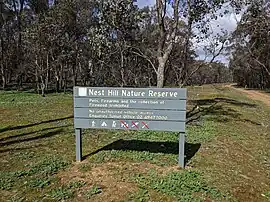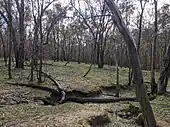| Nest Hill Nature Reserve New South Wales | |
|---|---|
 Entrance sign, Nest Hill Nature Reserve | |
 Nest Hill Nature Reserve | |
| Nearest town or city | Pulletop |
| Coordinates | 35°30′26.3″S 147°21′36″E / 35.507306°S 147.36000°E |
| Established | 1 January 2001[1] |
| Elevation | 380–450 m (1,247–1,476 ft)[1] |
| Area | 7.59 km2 (2.9 sq mi)[1] |
| Managing authorities | NSW National Parks & Wildlife Service |
| Website | Nest Hill Nature Reserve |
| See also | Protected areas of New South Wales |
Nest Hill Nature Reserve is a protected nature reserve, located in the South Western Slopes region of New South Wales, in eastern Australia.[1] The 759 ha (1,880-acre) reserve is located approximately 25 km (16 mi) north of Holbrook, and 35 km (22 mi) south of Wagga Wagga.[1]
History
The reserve lies within Wiradjuri country, however little is known about its historic significance to Aboriginal people.[1] The lack of permanent water within the reserve suggests that it may have been of low importance.[1]
The reserve was gazetted as Pulletop State Forest on 4 May 1917,[2] and managed by the Forestry Commission of NSW for logging and timber harvesting activities.[3] The state forest was reclassified as a nature reserve on 1 January 2001.[1] The name Nest Hill is derived from a dominant peak of the same name located 5 km (3.1 mi) south of the reserve.[1]
Environment
Nest Hill Nature Reserve is situated on the undulating slopes of County Ridge and is relatively flat in comparison to the surrounding landscape.[1] The reserve is generally dry for most of the year, with flowing water only usually accumulating after summer storms or during the wetter winter months.[1]
Flora
119 plant species have been recorded within the reserve, of which 91 were native, and 28 were introduced.[4] Large tree species present within the reserve include white box, red stringybark, red box and scribbly gum.[4]
Native plant species recorded within the reserve include chocolate lily, twining fringe-lily, bulbine lily, early nancy, dusky fingers, common onion orchid, purple burr-daisy, grass tree, box-leaf wattle, silver wattle, woolly wattle, hairy geebung and creamy candles.[4]
The reserve has limited native vegetation structure in the midstorey and understorey due to historic livestock grazing and ongoing grazing by kangaroos.[1]
Fauna
Four species of reptiles, 20 species of birds, and 7 species of mammals have been recorded within the reserve.[1] Four bird species listed under the Biodiversity Conservation Act 2016 have been recorded within the reserve, including black-chinned honeyeater, brown treecreeper, diamond firetail and speckled warbler.[3]
Introduced pest species found within the reserve include European fox and European rabbit.[1]

See also
References
- 1 2 3 4 5 6 7 8 9 10 11 12 13 14 Nest Hill Nature Reserve: Plan of management (PDF) (PDF). Government of New South Wales. May 2006. ISBN 1-74122-065-3. Retrieved 1 September 2023.
- ↑ "National Park Estate (Southern Region Reservations) Act 2000- Schedule 1". New South Wales Consolidated Acts. Australasian Legal Information Institute. Retrieved 2 September 2023.
- 1 2 Nest Hill Nature Reserve Fire Management Strategy (PDF) (PDF). NSW National Parks & Wildlife Service. September 2005. ISBN 1-74137-809-5. Retrieved 1 September 2023.
- 1 2 3 Burrows, Geoff E. (1999). "A survey of 25 remnant vegetation sites in the South Western Slopes, New South Wales". Cunninghamia. 6 (2): 283–314.